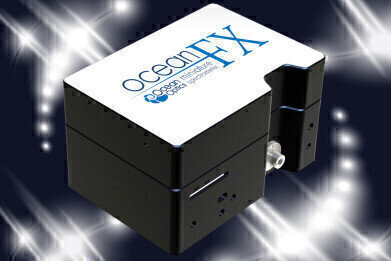Environmental laboratory
New Ocean FX Spectrometer Offers Higher Acquisition Speed for Light Measurement
Jan 31 2018
Characterise frequency, amplitude and chromatic variation of lighting.
Ocean Optics has upgraded its Ocean FX miniature spectrometer to now offer an acquisition speed of up to 4,500 scans per second, high-sensitivity CMOS detector performance and integration times as low as 10 µs. With flexible features to manage saturation intensity, it is suitable for high-intensity LED and light source measurement, laser characterisation, spectral analysis of rapid events and plasma monitoring.
Depending on the performance of the operating system to which it is connected, Ocean FX can acquire up to 4,500 scans per second. This speed allows users to collect more spectral information over shorter periods of time, contributing to better results. The high speed is also useful for capturing rapidly occurring modulation of light output, such as flicker in LEDs and other sources (see Ocean Optics Application Note: https://oceanoptics.com/ocean-fx-high-speed-applications-in-home-lighting/). The powerful onboard processor holds up to 50,000 spectra in its memory and can perform averaging of up to 5,000 spectra, significantly speeding transfer times and reducing bandwidth requirements.
Ocean FX is anchored by a high-sensitivity CMOS detector that is responsive from 200-1,100 nm. To account for varying light intensity, its adjustable integration time ranges from 10 seconds down to 10 µs. This ability to integrate over much briefer periods – microseconds instead of milliseconds – avoids saturating the detector in even extremely high-intensity applications. Ocean FX’s interchangeable slits give users the ability to further adjust for differences in light source intensity.
Users can operate the Ocean FX via Gigabit Ethernet, Wi-Fi, USB and now SPI communication protocols. The addition gives OEM users greater design flexibility, eliminating the need for cables or additional circuitry to convert signals. Ocean FX is available in versions optimised for the UV-Vis (200-850 nm), Vis-NIR (350-1,000 nm) and extended (200-1,025 nm) wavelength ranges. Enhanced-sensitivity, custom and OEM configurations are also available.
Digital Edition
IET 35.2 March
April 2025
Air Monitoring - Probe Sampling in Hazardous Areas Under Extreme Conditions - New, Game-Changing Sensor for Methane Emissions - Blue Sky Thinking: a 50-year Retrospective on Technological Prog...
View all digital editions
Events
May 06 2025 Nuremberg, Germany
May 10 2025 Karachi, Pakistan
May 11 2025 Vienna, Austria
May 11 2025 Seoul, South Korea
Salon Analyse Industrielle & Instrumentation
May 14 2025 Paris, France







_(4427399123)-(2).jpg)











